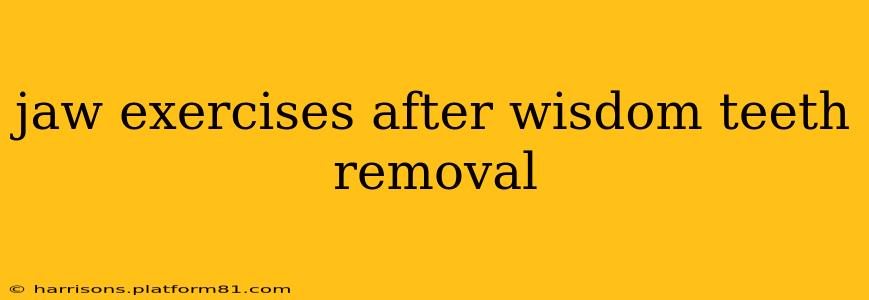Wisdom teeth removal is a common procedure, but the recovery process can be uncomfortable. Swelling, pain, and stiffness in the jaw are common side effects. While rest is crucial, gentle jaw exercises can aid in recovery, preventing stiffness and promoting healing. This guide will explore safe and effective jaw exercises following wisdom teeth removal, addressing common concerns and providing a path to a comfortable recovery. We'll also address frequently asked questions to ensure you have a complete understanding of the process.
What are the best jaw exercises after wisdom teeth removal?
The key is gentle movements. Avoid any exercises that cause significant pain. Start with very small movements and gradually increase the range of motion as your comfort level allows. Here are some suggestions:
-
Chin Tucks: Gently tuck your chin towards your chest, hold for a few seconds, and release. Repeat several times. This helps improve neck and jaw mobility without straining the extraction sites.
-
Tongue Movements: Gently move your tongue around your mouth, touching the roof, cheeks, and floor. This encourages blood flow and helps prevent stiffness. Avoid applying pressure directly to the extraction sites.
-
Mouth Opening and Closing: Slowly open and close your mouth, keeping the movements small and controlled. Stop if you experience any pain.
-
Side-to-Side Jaw Movements: Gently move your jaw from side to side, again keeping the movements very small and controlled.
When can I start doing jaw exercises after wisdom teeth removal?
It's generally recommended to wait at least 24-48 hours after your wisdom teeth removal before attempting any jaw exercises. The initial healing period is crucial, and early exertion could dislodge blood clots or hinder the healing process. Always follow your oral surgeon's specific instructions. They know your individual case best and can offer tailored advice.
How often should I do jaw exercises after wisdom teeth removal?
Start with short sessions, perhaps 2-3 times a day, for a few minutes at a time. As your discomfort subsides, you can gradually increase the duration and frequency of your exercises. Listen to your body and stop if you experience any pain.
Are there any jaw exercises I should avoid after wisdom teeth removal?
Yes, avoid any exercises that cause pain, pulling or stretching sensations near the extraction sites. Aggressive chewing or yawning should be avoided for at least a week post-surgery. Avoid any movements that might disrupt the blood clots forming in the extraction sockets. This could lead to complications like dry socket.
What if my jaw is still stiff after a week of gentle exercises?
If your jaw remains stiff despite gentle exercises, consult your oral surgeon or dentist. They can assess your progress and recommend additional strategies, potentially including physiotherapy or other therapies. Persistent stiffness could indicate a more significant issue requiring professional attention.
What are the benefits of doing jaw exercises after wisdom teeth removal?
Gentle jaw exercises offer several benefits during recovery:
- Reduced Stiffness: Regular movements help prevent jaw stiffness and improve range of motion.
- Pain Management: Improved blood circulation can reduce pain and inflammation.
- Faster Healing: Enhanced blood flow promotes faster tissue regeneration.
- Prevention of Complications: Maintaining jaw mobility can help prevent complications such as temporomandibular joint (TMJ) dysfunction.
How long should I continue jaw exercises after wisdom teeth removal?
You should continue jaw exercises until your jaw feels normal and your range of motion is restored. This typically takes a few weeks, but it can vary depending on the individual and the complexity of the surgery.
Remember: Always consult your oral surgeon or dentist before starting any post-surgical exercises. They can provide personalized guidance and ensure your recovery progresses safely and effectively. This information is for general knowledge and shouldn't replace professional medical advice. Prioritize your healing and follow your doctor's recommendations closely for optimal recovery.
